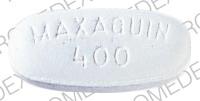Lomefloxacin Dosage
Applies to the following strengths: 400 mg
Usual Adult Dose for:
- Bronchitis
- Cystitis
- Prostatitis
- Salmonella Enteric Fever
- Salmonella Gastroenteritis
- Shigellosis
- Transurethral Prostatectomy
- Urinary Tract Infection
Additional dosage information:
Usual Adult Dose for Bronchitis
400 mg orally once a day for 10 days
Usual Adult Dose for Cystitis
400 mg orally once a day for 3 days
Duration: 3 days if caused by E coli in females; 10 days if caused by K pneumoniae, P mirabilis, or S saprophyticus
Usual Adult Dose for Prostatitis
400 mg orally once a day for 14 to 30 days
Usual Adult Dose for Salmonella Enteric Fever
400 mg orally once a day for 7 to 14 days
Usual Adult Dose for Salmonella Gastroenteritis
400 mg orally once a day for 3 days
Usual Adult Dose for Shigellosis
400 mg orally once a day for 3 to 5 days
Usual Adult Dose for Transurethral Prostatectomy
400 mg orally 2 to 6 hours prior to procedure
Usual Adult Dose for Urinary Tract Infection
Complicated: 400 mg orally once a day for 14 days
Renal Dose Adjustments
CrCl 10 to 40 mL/min: Loading dose of 400 mg followed by 200 mg orally once a day
Liver Dose Adjustments
No adjustment recommended
Dose Adjustments
It is suggested that serial determinations of lomefloxacin levels be performed to determine any necessary alteration in the appropriate next dosing interval for renal dysfunction patients.
Precautions
Recommended doses should not be exceeded due to increased risk of QT interval prolongation. Discontinue use and initiate appropriate therapy if signs of QT interval prolongation, seizures, neuropathy, or hypersensitivity occur.
Patients should be advised to avoid direct or indirect exposure to sunlight and artificial UV light, and to take lomefloxacin at least 12 hours before exposure to sunlight (in the evening) as this may decrease the risk of phototoxic reactions. The drug should be discontinued if signs of phototoxicity occur (e.g., sunburn, redness, burning, itching, rash, blistering).
Patients should be advised to discontinue the drug, rest, and avoid exercise if they experience pain, inflammation or rupture of a tendon.
Clostridium difficile associated diarrhea (CDAD) has been reported with almost all antibiotics and may potentially be life-threatening. Therefore, it is important to consider this diagnosis in patients who present with diarrhea following quinolone therapy. Mild cases generally improve with discontinuation of the drug, while severe cases may require supportive therapy and treatment with an antimicrobial agent effective against C difficile. Hypertoxin producing strains of C difficile cause increased morbidity and mortality; these infections can be resistant to antimicrobial treatment and may necessitate colectomy.
The patient should be well hydrated or instructed to drink plenty of water to avoid formation of highly concentrated urine.
Renal, hepatic, and hematopoietic function should be monitored periodically during therapy.
Dosage adjustments are recommended for renally impaired patients. Caution and monitoring is recommended for elderly patients, who may be at a greater risk of adverse reactions due to declining renal function.
Lomefloxacin may cause dizziness or lightheadedness. Patients should be advised to avoid driving or engaging in other tasks requiring alertness and coordination until they know how the drug affects them.
Due to cartilage erosion and arthropathy reported in studies with juvenile animals, the safety and effectiveness of lomefloxacin in pediatric patients and adolescents less than 18 years have not been established.
Dialysis
Conventional hemodialysis removes only a negligible amount of lomefloxacin (3%). Hemodialysis patients should receive an initial loading dose of 400 mg followed by daily maintenance doses of 200 mg once a day.
Other Comments
Lomefloxacin may be taken without regard to meals. Patients should be advised to drink plenty of fluids. Doses should be administered at least 4 hours before or 8 hours after iron-, zinc-, aluminum-, or magnesium-containing compounds (e.g., antacids, sucralfate, mineral supplements, buffered didanosine).
More about lomefloxacin
- Check interactions
- Compare alternatives
- Side effects
- During pregnancy
- Drug class: quinolones and fluoroquinolones
- Breastfeeding
Related treatment guides
Further information
Always consult your healthcare provider to ensure the information displayed on this page applies to your personal circumstances.


